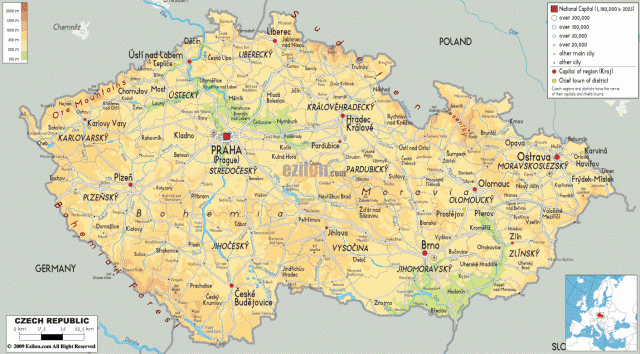Czech Republic
Area 30,450 square mi (78,866 square km)
Population 10.51 million 2014
Capital Prague
Highest Point 5,256 ft (1,602 m)
Lowest Point 377 ft (115 m)
GDP $205.5 billion 2014
Primary Natural Resources graphite, coal, timber.
THE CZECH REPUBLIC consists of the two historic regions of Bohemia and Moravia. The Czech Republic borders SLOVAKIA to the southeast, POLAND to the north and northeast, GERMANY to the north and west, and AUSTRIA to the south. The Czech Republic is a parliamentary democracy with a parliament as its legislature. The prime minister serves as the head of government, and the president serves as head of state. Prague, Brno, Ostrava, and Plzen are major cities of the country.
Bohemia is a PLATEAU surrounded by the Ore or Erzgebirge Mountains and the Sudetes Mountains on the north and drained by the Vltava. Moravia is a lowland region that is drained by the Morava River, which flows into the DANUBE. The climate in the Czech Republic varies with the region from 30 degrees F (-1 degree C ) in January to 67 degrees F (19.4 degrees C) in July. In higher elevations, the climate is colder and receives more rain.

The region comprising the Czech Republic was first settled by two Celtic groups, the Boii, from which the region Bohemia gets its name, and the Cotini. By the 5th century, Slavs from the east settled in the region and formed the kingdom of Bohemia in the 10th century. In the 15th century, Jan Hus led a movement against the Roman Catholic Church, which presaged the Protestant Reformation a century later. In 1526, the Habsburg dynasty from Austria gained control of the Bohemian throne.
The Thirty Years' War began in Prague when the Czechs rebelled against Habsburg rule in 1618. By 1620, Czech forces were defeated by the Habsburg forces, placing Bohemia under Austrian rule for 300 years. The convulsions of World War I led Czech leaders to push for full independence. In 1918, Czechoslovakia, with a diverse population of Czechs, Slovaks, Germans, and Ruthenians, emerged as a successor state to the Austro-Hungarian Empire. The First Republic of Czechoslovakia, led by Thomas Masaryk, was organized as a Western democracy, which was one of the most stable and prosperous countries of Central Europe during the interwar period. During the 1930s, as Europe witnessed the rise of fascism, Czechoslovakia fell prey to Nazi ambitions.
In September 1938, at the Munich Conference, Britain and FRANCE gave the German-populated Sudetenland in northern Czechoslovakia to Adolf Hitler, who reorganized the country into the Second Republic in 1939 as a Nazi puppet state, granting autonomy to Slovakia. Liberated by the Soviets in 1945, Czechoslovakia reemerged as an independent nation. By 1948, however, the communists, with the backing of the Soviet Union, took control of the government, creating the Third Republic. All prewar political parties were banned, and anticommunists were convicted in show trials.
The communists nationalized all industry, collectivized all agriculture, and restricted all churches in the years immediately following World War II. In 1968, President Alexander Dubcek proposed liberal reforms to the political and economic system, which included distancing Czechoslovakia from the Soviet Union. This “socialism with a human face” was put down by intervention by the Soviet Union and members of the Warsaw Pact, and Czechoslovakia was placed in a tighter orbit with Moscow. By 1989, pressures for change throughout Eastern and Central Europe led to the Velvet Revolution, which overthrew communist rule in Czechoslovakia. Dissident Vaclav Havel became president of Czechoslovakia and he oversaw its transition to democracy, with Vaclav Klaus as prime minister to oversee economic reform. The Velvet Revolution raised the age-old question of the relationship between the Czechs and the Slovaks, and by 1993 came the Velvet Divorce, which was the peaceful split of Czechoslovakia into the Czech Republic and SLOVAKIA. Since then, the Czech Republic has made strides to integrate into the European economy. It has been one of the few Eastern and Central European states to make a successful transition to a free market economy, albeit with some difficulties in the rising inequality of wealth. The Czech Republic joined the NORTH ATLANTIC TREATY ORGANIZATION in 1999 and the EUROPEAN UNION in 2004.
Czechs make up the majority of the population of the Czech Republic. Sizable minorities of Slovaks and Roma (Gypsies) also reside in the Czech Republic. A significant German population existed in the Sudetenland, but many were expelled after World War II. The Czech Republic has had an industrialized economy since the days of the Austro-Hungarian Empire. Its chief exports are consumer goods, and machinery. Its chief industries are machinery, automobiles, textiles, and glass. Its imports are consumer goods and fuel.